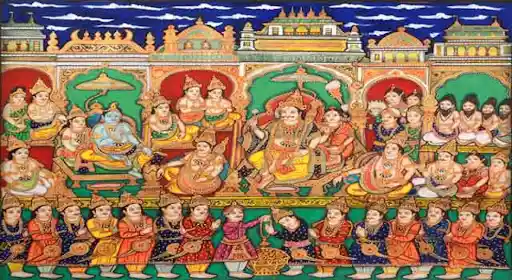Cosmopolitanism in Indian Art Through a Historical Lens
Cosmopolitanism is a cultural phenomenon of our society that is often denoted by its openness to other cultures, traditions, people, beliefs, and traditions. In the scenario of Indian art, we find that the diversity and relatability and cosmopolitanism of Indian art, its origin and existence have not been explored amply. Who were the patrons of ancient art in India? How has that changed now and what does art translate to, to people of 21st century India? We do not have conclusive historical evidence to quantify what these questions ask. This article delves deeper into this question.

(Contemporary Art in India. Source: Google)
The origins of Indian art go back to the roots of civilization. It is believed that most of the Indian art forms originated when the Indus civilization was at its peak. A comprehensive history of art from those times to the present requires an organized table exploring each age and its artistic revelations.
Jumping to the present context which is the focal point of this story, Indian modernists were pioneers in shaping the narrative of Indian art in the contemporary world. These highly talented artists including Abanindranath Tagore, Raja Ravi Varma, Mahadev Vishwanath Dhurandar, and Pestonjee Banerjee, defined their artistic sensibilities and pursued relentless creativity during the tumultuous decades surrounding India's independence. Constantly experimenting and evolving at different stages of their careers, they created seminal works that received critical acclaim and gave Indian art a new identity, for example, Bharat Mata by Abanindranath, Shakuntala by Raja Ravi Varma, Women at Work by Mahadev Vishwanath which mirrored the current scenario of the Indian society crumbling down to the colonial power. These paintings were symbols of resistance and truth that instilled an idea of artistic confidence in people’s minds.
A pivotal moment in the history of Indian art that occurred during the period of Western influence on the nation's heritage was the arrival of Vasco da Gama at the end of the 15th century who established direct trade relations with India. In the 17th century, France, Holland, Denmark and England gradually began to facilitate trade with India. After the fall of Maratha's rule in the 18th century, European powers began invading India from various regions. The defeat of Tipu Sultan increased British power, and by the mid-19th century, the country was under the rule of the British Empire. The Western and European influences of this period on India are still felt today in Indian culture and art. This fused local artistic traditions with foreign influences. His style developed in romantic India, exaggerating traditional ornamentation to the delight of European buyers.
Traditional Indian art consists of religious figures (gods and idols) from Hinduism and Buddhism which have been common themes for centuries. Sculptures and cave paintings found in antiquity mainly showed human, mythological, elaborate ornaments and animal forms. In the Middle Ages, Islamic and Indian art did not omit figurative expressions. Each art style is unique in its way and is highly commendable. Traditionally, these art styles existed only in murals or wall paintings. Today, however, it can also be found on canvas, paper, and fabric. Here is a list of different Indian art styles. Some are still practised and some are not. Due to the diversity of geography, climate, demographics, and local cultural traditions, the country has a wide variety of painting styles. Indian art has been shaped along with developing regional borders due to varied artistic influences. Indian painting and art form is an intricate patchwork of different styles and approaches to figure painting and painting.
Eventually, as we embraced modernity, the transition accompanied the adoption of several art styles that evolved generationally, becoming more diverse, through the process of cultural acculturation and assimilation. They became more diverse and more relatable for people around the world.


